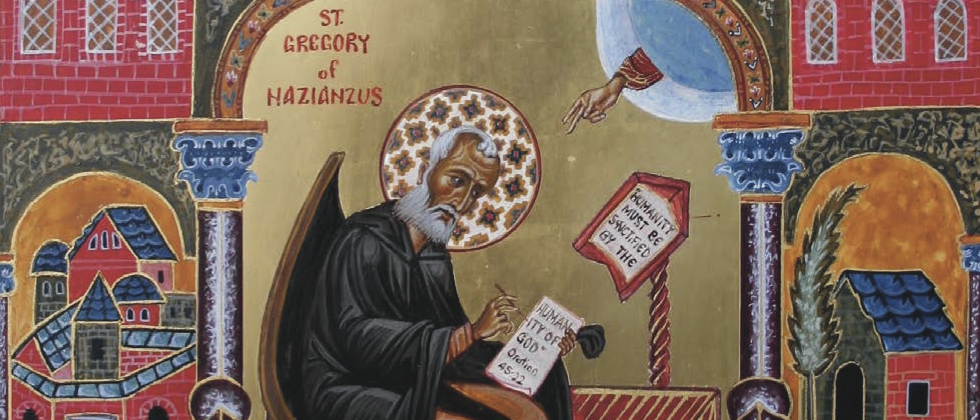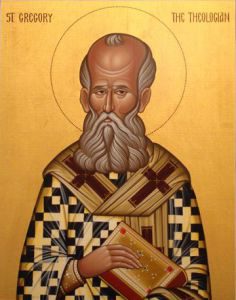
St. Gregory Nazianzen was a monk and bishop, a Father and Doctor of the Church, who defended the Catholic truth against the Arian heresy. Gregory was born about the year 329 at Arianzus, Cappadocia in Asia Minor, or modern-day Turkey. His mother, Nonna, converted her husband (also Gregory) after her own conversion to Christianity, and the senior Gregory became the Bishop of Nazianzus. They and all three of their children are saints. The family was wealthy and lived on a large estate. As a youth, Gregory resolved to remain chaste after a dream or vision of some kind. He began his extensive education at nearby Caesarea in Cappadocia, where he was tutored by the esteemed teacher Carterius. While there, he became close friends with [St.]Basil the Great, a fellow student. Next, he went to Caesarea in Palestine, where he studied under Thespesius; to Alexandria, Egypt, and lastly to Athens, Greece, where he again studied with Basil. He remained a student in Athens for ten years, and returned to Cappadocia at age thirty.
From solitude to service
While he was discerning whether to follow a career in law or rhetoric, or to follow the path of monasticism, Gregory met again with Basil, and decided to join him in a newly-formed monastic group at Pontus near the Black Sea. There, he worked with Basil to compose his Rule for monastic life. In 361, just two years after his monastic life had begun, Gregory returned to Nazianzus to help his father. The senior Gregory, now in his eighties, had had insufficient theological formation and had signed a faulty creed, of heretical Arian origin. Young Gregory guided his father back to orthodoxy and helped him to govern his jurisdiction. The senior Gregory prevailed upon his unwilling son to be ordained, and on Christmas Day 361, father ordained son. Days later, young Gregory fled back to the monastery at Pontus, overwhelmed with the responsibilities of his ordination. There, he made his peace with his new responsibility. In the meantime, Basil had been made Archbishop of Caesarea in Cappadocia. In 372, he created a new diocese at Sasima, an insignificant town with a largely transient populace, and he named his friend Gregory to be its first bishop. This new diocese was located in an area with a lot of social strife and was firmly under the influence of Arian heretical beliefs, and Gregory had no interest in going there. He was greatly unhappy at Sasima and left to return to Nazianzus, where he became co-adjutor bishop under his father, giving him the right of succession. Gregory was troubled that his friend would send him to such an undesirable outpost and Basil was disappointed that Gregory would abandon his see, causing unfortunate damage to a long valued friendship. At Nazianzus, the senior Gregory died in 374, leaving young Gregory to assume his duties. Since he had no intention of serving as bishop, he remained as an administrator until another bishop could be named. After his mother also died, he gave most of his family inheritance to the poor. In 375, he came down with a severe illness, and went to a monastery at Seleucia, Isauria. He remained there for five years, convalescing from his illness and living a penitential life.
Brilliance in Constantinople
In 379, a new Eastern emperor was crowned. A group of bishops convinced the emperor to summon Gregory to Constantinople to help restore orthodoxy to the large and important see. There, he established a small parish, called Anastasia (meaning Resurrection), where his oratorical skills were discovered. Even though the persecution by those favoring Arianism was intense, Gregory became fearless in his preaching of authentic Church teaching, especially regarding Christology. His preaching put him in serious danger, for the conflict over the heresy was the cause of much intrigue and violence. By all accounts, the preaching of Gregory was both brilliant and persuasive, causing a tremendous wave of converts. Emperor Theodosius became convinced of these truths, requested Baptism, and banished the Arian bishops. Gregory was named Archbishop of Constantinople, much against his wishes. He knew that what he was called to do at Constantinople had been accomplished with the toppling of Arianism there. He resigned his see in 381, and returned to Nazianzus, where he tended to the needs of the church there. With time, his health declined and he made his last journey to Arianzus, where he lived his final years in great austerity on the fragment of the family estate which he had retained. He died January 25, 389. His body lies at St. Peter’s Basilica in Vatican City.

Gregory’s precious legacy
St. Gregory Nazianzen wrote numerous homilies, letters, epistles, and poems. Most noteworthy are the five Theological Discourses presented at Constantinople in 380, and it is primarily because of these that he is also known as Gregory the Theologian, a title first given to him by St. John Chrysostom. For many centuries, these reliable discourses were used and studied by scholars and teachers in explaining the truths about the Holy Trinity. It was he who used the word “proceed” in explaining how the Holy Spirit comes forth from the Father and the Son. He also defended the use of the word “Theotokos” (God bearer) for the Virgin Mary as part of the defense of Christ’s full divinity and full humanity. His many years of classical education and hours of prayer, meditation, and solitude made his preaching and writing skills highly effective. Gregory was a monk and a scholar at heart, and truly had no interest in any pomp or administration. Although he preferred his solitude, when duty called him forth on behalf of defending and protecting the truths of the Faith, he overcame his shyness and aversion to activity and heroically served the Kingdom at the epicenter of Eastern Christianity. His holiness was never in dispute, even from his Arian enemies. Along with his great friend St. Basil the Great and Basil’s brother St. Gregory of Nyssa, Gregory Nazianzen is one of the three Cappadocian Fathers highly venerated in Catholic and Orthodox Churches. He shares his feast day of January 2 with St. Basil.
